Numerical Investigation on Heat Transfer and Flow Resistance Characteristics of Superheater in Hydrocracking Heat Recovery Steam Generator
Abstract
:1. Introduction
2. Numerical Simulation
2.1. Physical Model and Boundary Condition
2.2. Governing Equations
- (1)
- The flow and heat transfer processes of the fluid are stationary-state.
- (2)
- The volume force ignores gravity and buoyancy.
- (3)
- The external surface of the model is configured as an insulated wall condition, and the interchange of heat between the flue gas and the environment is ignored.
- (4)
- The influence of particles in gas on the flow and heat transfer process is ignored.
- (5)
- The physical parameters of the tube bundle are set as constants and the physical parameters of the gas and superheated vapor are fitted as a function of temperature.
2.3. Grid Independence Verification
2.4. Evaluation Indexes
2.5. Model Validation
3. Results and Discussion
3.1. Temperature and Velocity Distribution
3.2. Effect on Transverse Tube Pitch and Longitudinal Tube Pitch
3.3. Correlation Formula of Nu and Eu
4. Conclusions
5. Prospects
Author Contributions
Funding
Data Availability Statement
Conflicts of Interest
Nomenclature
| ST transverse tube pitch (mm) | SL longitudinal tube pitch (mm) |
| di inner diameter (mm) | do outer diameter (mm) |
| ug,i velocity of gas inlet (m/s) | uv,i velocity of vapor inlet (m/s) |
| Tg,i temperature of gas inlet (K) | Tv,i temperature of vapor inlet (K) |
| Re Reynolds number | Nu Nusselt number |
| Eu Euler number | PEC performance evaluation criteria |
| Greek symbols | |
| λv thermal conductivity of vapor (W/(m·K)) | λg thermal conductivity of gas (W/(m·K)) |
| μg viscosity of gas (Pa·s) | μv viscosity of vapor (Pa·s) |
| ρg density of gas (kg/m3) | ρv density of vapor (kg/m3) |
| Cpg specific heat of gas (J/kg·K) | Cpv specific heat of vapor (J/kg·K) |
References
- Dickerson, T.; Soria, J. Catalytic Fast Pyrolysis: A Review. Energies 2013, 6, 514–538. [Google Scholar] [CrossRef]
- Min, Q.; Lu, Y.; Liu, Z.; Su, C.; Wang, B. Machine Learning based Digital Twin Framework for Production Optimization in Petrochemical Industry. Int. J. Inf. Manag. 2019, 49, 502–519. [Google Scholar] [CrossRef]
- Sadrameli, S.M. Thermal/catalytic cracking of liquid hydrocarbons for the production of olefins: A state-of-the-art review II: Catalytic cracking review. Fuel 2016, 173, 285–297. [Google Scholar] [CrossRef]
- Abuhasel, K.; Kchaou, M.; Alquraish, M.; Munusamy, Y.; Jeng, Y.T. Oily Wastewater Treatment: Overview of Conventional and Modern Methods, Challenges, and Future Opportunities. Water 2021, 13, 980. [Google Scholar] [CrossRef]
- Elliott, D.C. Historical developments in hydroprocessing bio-oils. Energy Fuels 2007, 21, 1792–1815. [Google Scholar] [CrossRef]
- Lopez, G.; Artetxe, M.; Amutio, M.; Bilbao, J.; Olazar, M. Thermochemical routes for the valorization of waste polyolefinic plastics to produce fuels and chemicals. A Review. Renew. Sustain. Energy Rev. 2017, 73, 346–368. [Google Scholar] [CrossRef]
- Rana, M.S.; Samano, V.; Ancheyta, J.; Diaz, J.A.I. A review of recent advances on process technologies for upgrading of heavy oils and residua. Fuel 2007, 86, 1216–1231. [Google Scholar] [CrossRef]
- Akcil, A.; Veglio, F.; Ferella, F.; Okudan, M.D.; Tuncuk, A. A review of metal recovery from spent petroleum catalysts and ash. Waste Manag. 2015, 45, 420–433. [Google Scholar] [CrossRef]
- Farias, C.B.B.; Almeida, F.C.G.; Silva, I.A.; Souza, T.C.; Meira, H.M.; Soares da Silva, R.d.C.F.; Luna, J.M.; Santos, V.A.; Converti, A.; Banat, I.M.; et al. Production of green surfactants: Market prospects. Electron. J. Biotechnol. 2021, 51, 28–39. [Google Scholar] [CrossRef]
- Sadrameli, S.M. Thermal/catalytic cracking of hydrocarbons for the production of olefins: A state-of-the-art review I: Thermal cracking review. Fuel 2015, 140, 102–115. [Google Scholar] [CrossRef]
- Vedrine, J.C. Heterogeneous Catalysis on Metal Oxides. Catalysts 2017, 7, 341. [Google Scholar] [CrossRef]
- Karimi, H.; Khani, M.R.; Gharibi, M.; Mahdikia, H.; Shokri, B. Plasma pyrolysis feasibility study of spent petrochemical catalyst wastes to hydrogen production. J. Mater. Cycles Waste Manag. 2020, 22, 2059–2070. [Google Scholar] [CrossRef]
- Wu, D.H. Advances in China’s refining and petrochemical catalysts. Catal. Today 1996, 30, 21–31. [Google Scholar] [CrossRef]
- Norouzi, E.; Amidpour, M. Optimal thermodynamic and economic volume of a heat recovery steam generator by constructal design. Int. Commun. Heat Mass Transf. 2012, 39, 1286–1292. [Google Scholar] [CrossRef]
- Taler, D.; Trojan, M.; Dzierwa, P.; Kaczmarski, K.; Taler, J. Numerical simulation of convective superheaters in steam boilers. Int. J. Therm. Sci. 2018, 129, 320–333. [Google Scholar] [CrossRef]
- Maakala, V.; Jarvinen, M.; Vuorinen, V. Computational fluid dynamics modeling and experimental validation of heat transfer and fluid flow in the recovery boiler superheater region. Appl. Therm. Eng. 2018, 139, 222–238. [Google Scholar] [CrossRef]
- Qi, J.; Zhou, K.; Huang, J.; Si, X. Numerical simulation of the heat transfer of superheater tubes in power plants considering oxide scale. Int. J. Heat Mass Transf. 2018, 122, 929–938. [Google Scholar] [CrossRef]
- Madejski, P.; Taler, D.; Taler, J. Modeling of transient operation of steam superheater in CFB boiler. Energy 2019, 182, 965–974. [Google Scholar] [CrossRef]
- Bang, Y.-M.; Park, S.R.; Cho, C.P.; Cho, M.; Park, S. Thermal and flow characteristics of a cylindrical superheater with circular fins. Appl. Therm. Eng. 2020, 181, 115895. [Google Scholar] [CrossRef]
- Laubscher, R.; Rousseau, P. Numerical investigation into the effect of burner swirl direction on furnace and superheater heat absorption for a 620 MWe opposing wall-fired pulverized coal boiler. Int. J. Heat Mass Transf. 2019, 137, 506–522. [Google Scholar] [CrossRef]
- Laubscher, R.; Rousseau, P. Coupled simulation and validation of a utility-scale pulverized coal-fired boiler radiant final-stage superheater. Therm. Sci. Eng. Prog. 2020, 18, 100512. [Google Scholar] [CrossRef]
- Laubscher, R.; Rousseau, P. CFD study of pulverized coal-fired boiler evaporator and radiant superheaters at varying loads. Appl. Therm. Eng. 2019, 160, 114057. [Google Scholar] [CrossRef]
- Zhou, Y.; Xu, T.; Hui, S.; Zhang, M. Experimental and numerical study on the flow fields in upper furnace for large scale tangentially fired boilers. Appl. Therm. Eng. 2009, 29, 732–739. [Google Scholar] [CrossRef]
- He, Y.L.; Han, H.; Tao, W.Q.; Zhang, Y.W. Numerical study of heat-transfer enhancement by punched winglet-type vortex generator arrays in fin-and-tube heat exchangers. Int. J. Heat Mass Transf. 2012, 55, 5449–5458. [Google Scholar] [CrossRef]
- Jang, J.Y.; Chen, L.K. Numerical analysis of heat transfer and fluid flow in a three-dimensional wavy-fin and tube heat exchanger. Int. J. Heat Mass Transf. 1997, 40, 3981–3990. [Google Scholar] [CrossRef]
- Li, J.; Wang, S.; Chen, J.; Lei, Y.-G. Numerical study on a slit fin-and-tube heat exchanger with longitudinal vortex generators. Int. J. Heat Mass Transf. 2011, 54, 1743–1751. [Google Scholar] [CrossRef]
- Modi, A.J.; Rathod, M.K. Comparative study of heat transfer enhancement and pressure drop for fin-and-circular tube compact heat exchangers with sinusoidal wavy and elliptical curved rectangular winglet vortex generator. Int. J. Heat Mass Transf. 2019, 141, 310–326. [Google Scholar] [CrossRef]
- Wen, J.; Gu, X.; Wang, M.; Liu, Y.; Wang, S. Multi-parameter optimization of shell-and-tube heat exchanger with helical baffles based on entransy theory. Appl. Therm. Eng. 2018, 130, 804–813. [Google Scholar] [CrossRef]
- Du, X.; Feng, L.; Yang, Y.; Yang, L. Experimental study on heat transfer enhancement of wavy finned flat tube with longitudinal vortex generators. Appl. Therm. Eng. 2013, 50, 55–62. [Google Scholar] [CrossRef]
- Zhang, J.; Zhao, Y.; Diao, Y.; Zhang, Y. An experimental study on fluid flow and heat transfer in a multiport minichannel flat tube with micro-fin structures. Int. J. Heat Mass Transf. 2015, 84, 511–520. [Google Scholar] [CrossRef]
- Gao, H.; Zhang, Y.; Liu, Y.; Wang, Y.; Sun, P.; Ma, Y.; Gu, Z.; Yu, W. Numerical simulation of heat transfer performance of different heat exchange tubes in heat recovery steam generator. Process Saf. Environ. Prot. 2022, 163, 506–512. [Google Scholar] [CrossRef]
- Unger, S.; Beyer, M.; Arlit, M.; Stasch, P.; Hampel, U. An experimental investigation on the air-side heat transfer and flow resistance of finned short oval tubes at different tube tilt angles. Int. J. Therm. Sci. 2019, 140, 225–237. [Google Scholar] [CrossRef]
- Zhang, J.-N.; Cheng, M.; Ding, Y.-D.; Fu, Q.; Chen, Z.-Y. Influence of geometric parameters on the gas-side heat transfer and pressure drop characteristics of three-dimensional finned tube. Int. J. Heat Mass Transf. 2019, 133, 192–202. [Google Scholar] [CrossRef]
- Tan, X.-H.; Zhu, D.-S.; Zhou, G.-Y.; Zeng, L.-D. Heat transfer and pressure drop performance of twisted oval tube heat exchanger. Appl. Therm. Eng. 2013, 50, 374–383. [Google Scholar] [CrossRef]
- Lemmon, E.W.; Bell, I.H.; Huber, M.L.; McLinden, M.O. NIST Standard Reference Database 23: Reference Fluid Thermodynamic and Transport Properties-REFPROP, version 10.0; Standard Reference Data Program; National Institute of Standards and Technology: Gaithersburg, MD, USA, 2018. [CrossRef]
- Wu, W.; Zhang, M.; Dong, H. Numerical investigation on flow and atomization characteristics of hydrated magnesium nitrate gas-liquid two-fluid nozzle. Proc. Inst. Mech. Eng. Part C J. Mech. Eng. Sci. 2023, 237, 83–94. [Google Scholar] [CrossRef]
- Yang, S.; Tao, W. Heat Transfer, 4th ed.; Higher Education Press: Beijing, China, 2006. [Google Scholar]
- Raithby, G.D.; Chui, E.H. A Finite-Volume Method for Predicting a Radiant Heat Transfer in Enclosures with Participating Media. J. Heat Transf. 1990, 112, 415–423. [Google Scholar] [CrossRef]
- Chui, E.H.; Raithby, G.D. Computation of Radiant Heat Transfer on a Non-Orthogonal Mesh Using the Finite-Volume Method. Numer. Heat Transf. Part B 1993, 23, 269–288. [Google Scholar] [CrossRef]
- Webb, R.L. Performance evaluation criteria for use of enhanced heat transfer surfaces in heat exchange design. Int. J. Heat Mass Transf. 1981, 24, 715–726. [Google Scholar] [CrossRef]
- Zhukauskas, A.A. Convective Heat Transfer in the Heat Exchanger; Science Press: Beijing, China, 1986. [Google Scholar]
- Hatipoglu, F.; Avci, I. Flow around a partly buried cylinder in a steady current. Ocean. Eng. 2003, 30, 239–249. [Google Scholar] [CrossRef]
- Zhang, H.; Yang, J.-M.; Xiao, L.-F.; Lu, H.-N. Large-eddy simulation of the flow past both finite and infinite circular cylinders at Re=3900. J. Hydrodyn. 2015, 27, 195–203. [Google Scholar] [CrossRef]
- Khan, W.A.; Culham, J.R.; Yovanovich, M.M. Convection heat transfer from tube banks in crossflow: Analytical approach. Int. J. Heat Mass Transf. 2006, 49, 4831–4838. [Google Scholar] [CrossRef]
- Hausen, H. Heat Transfer in Counterflow, Parallel-Flow and Cross Flow; McGraw-Hill: New York, NY, USA, 1983. [Google Scholar]
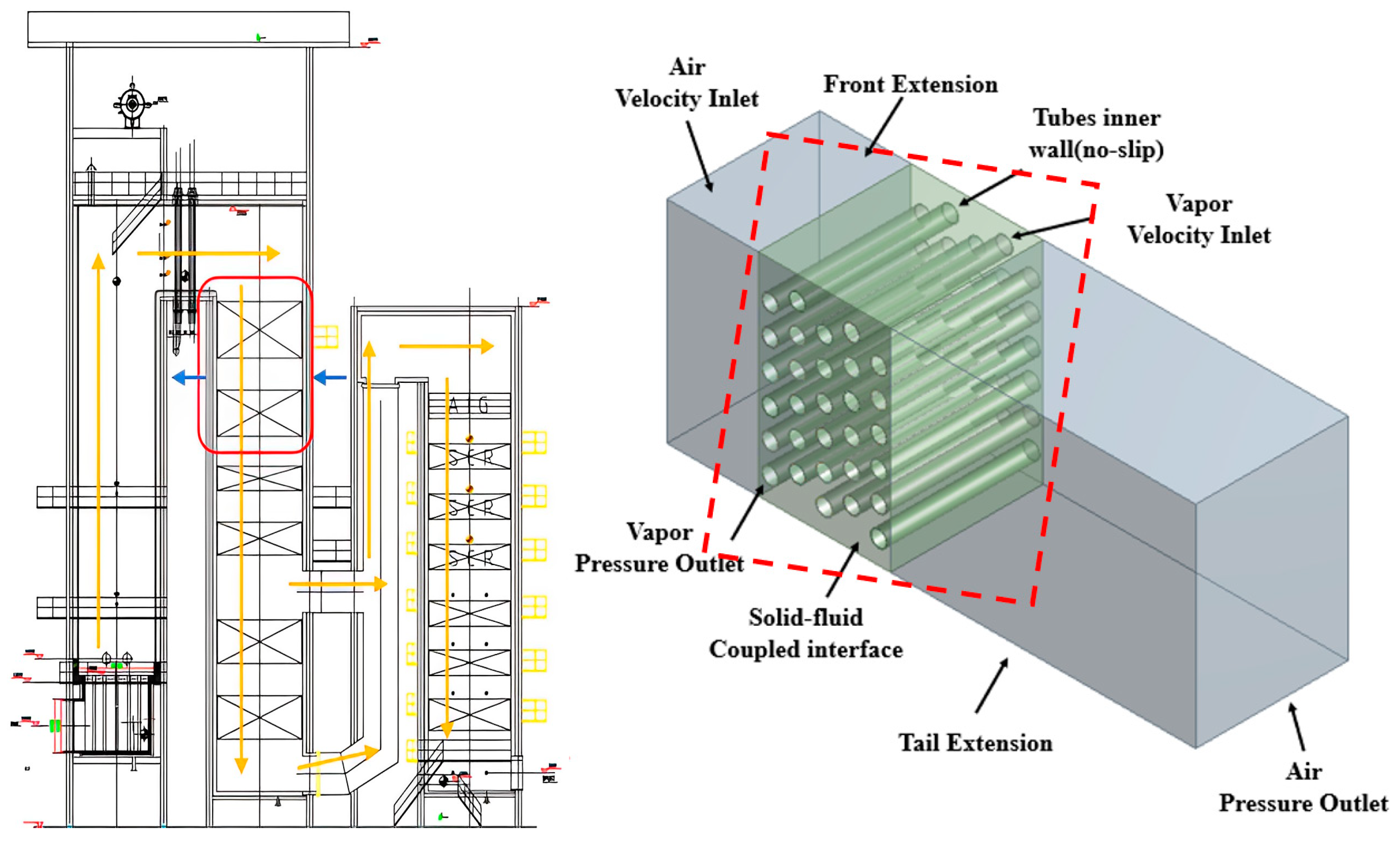

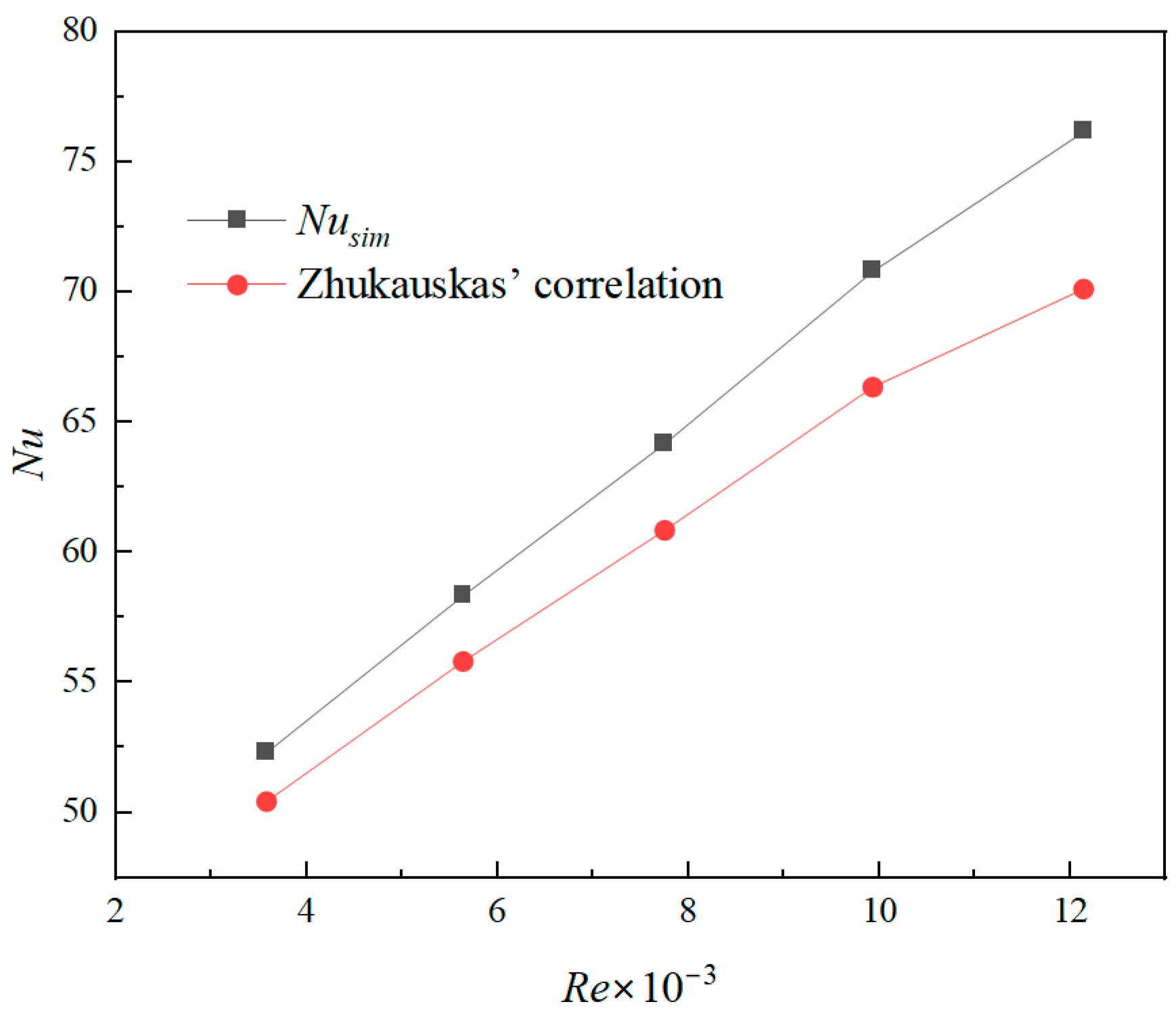

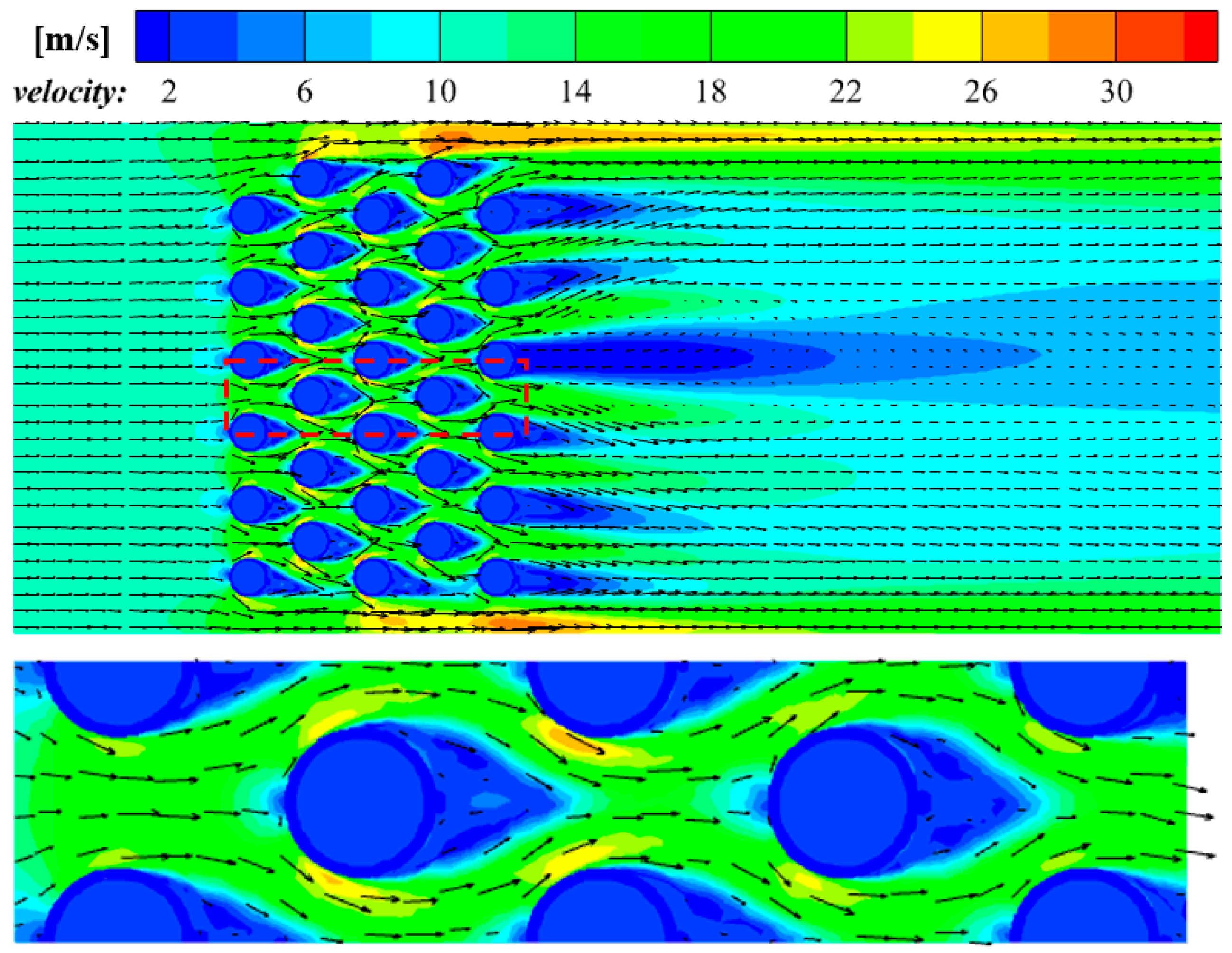
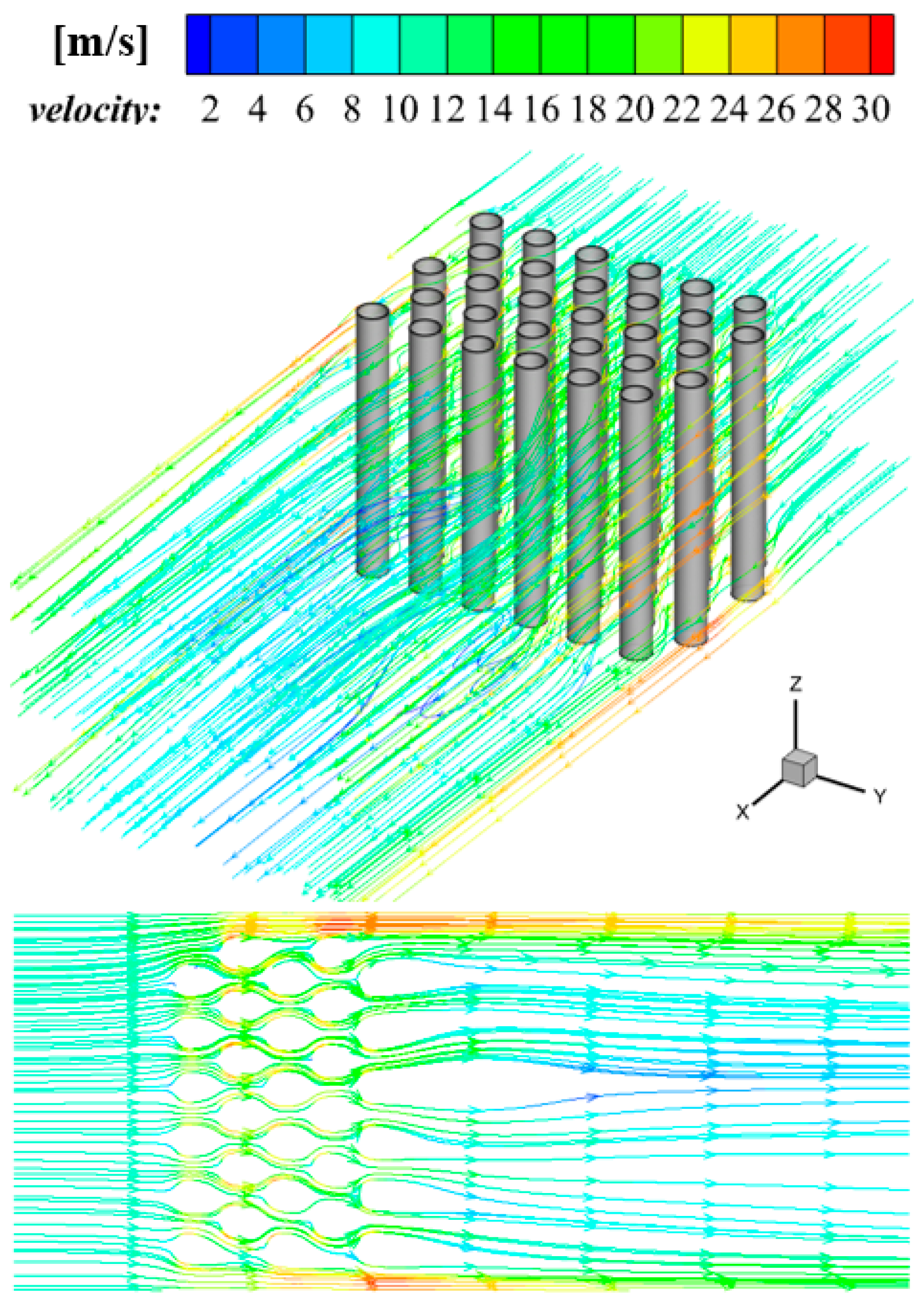
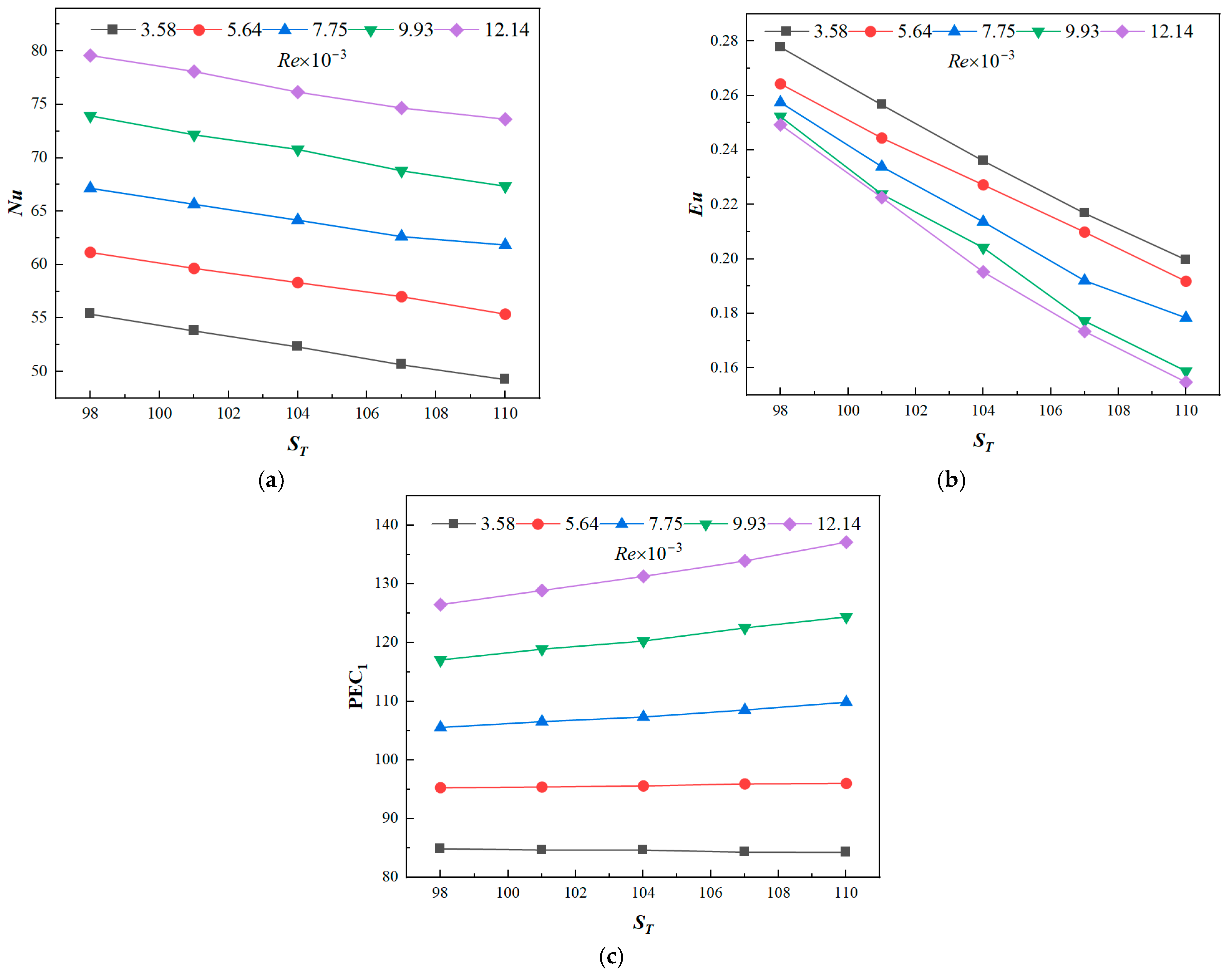
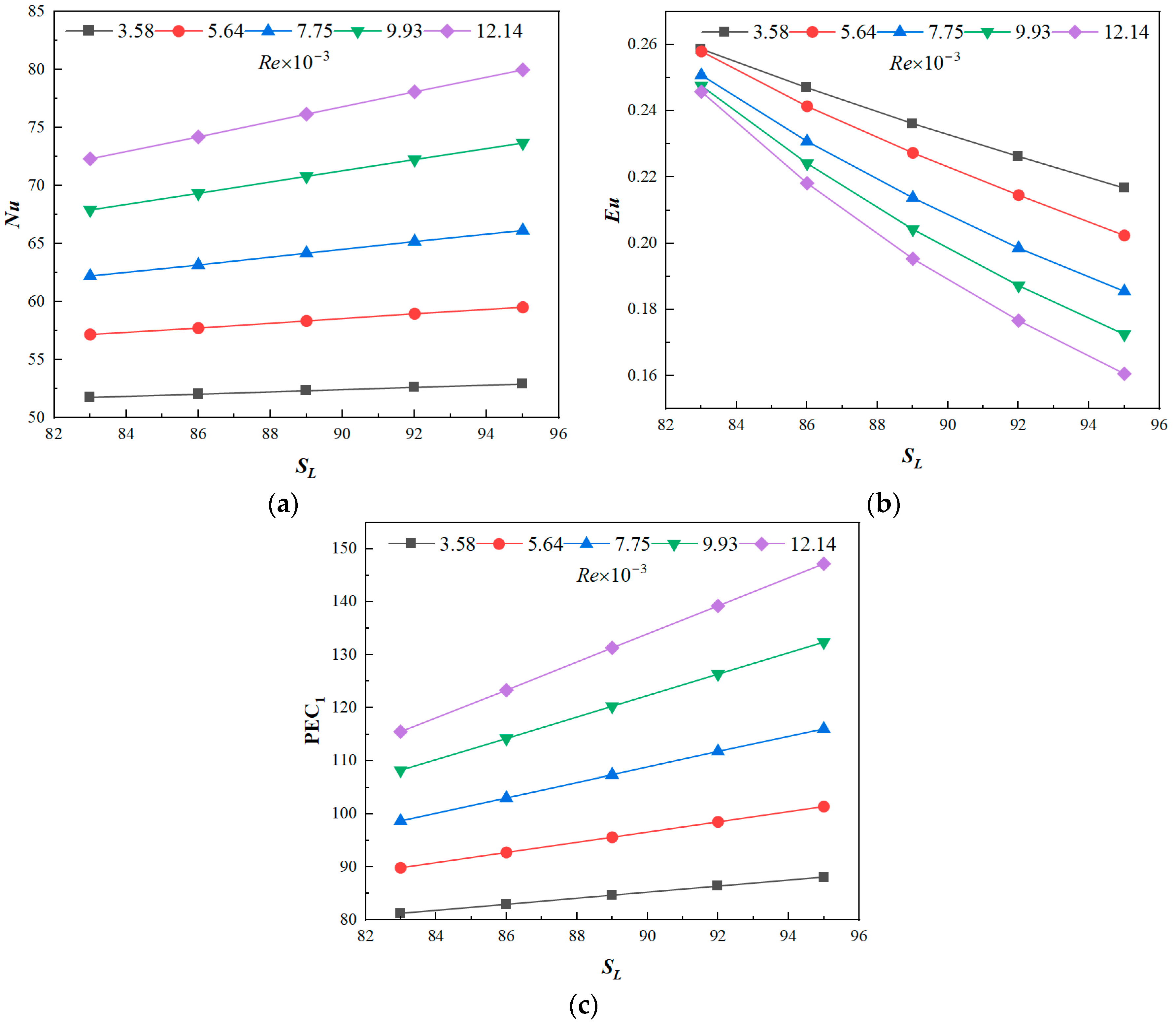

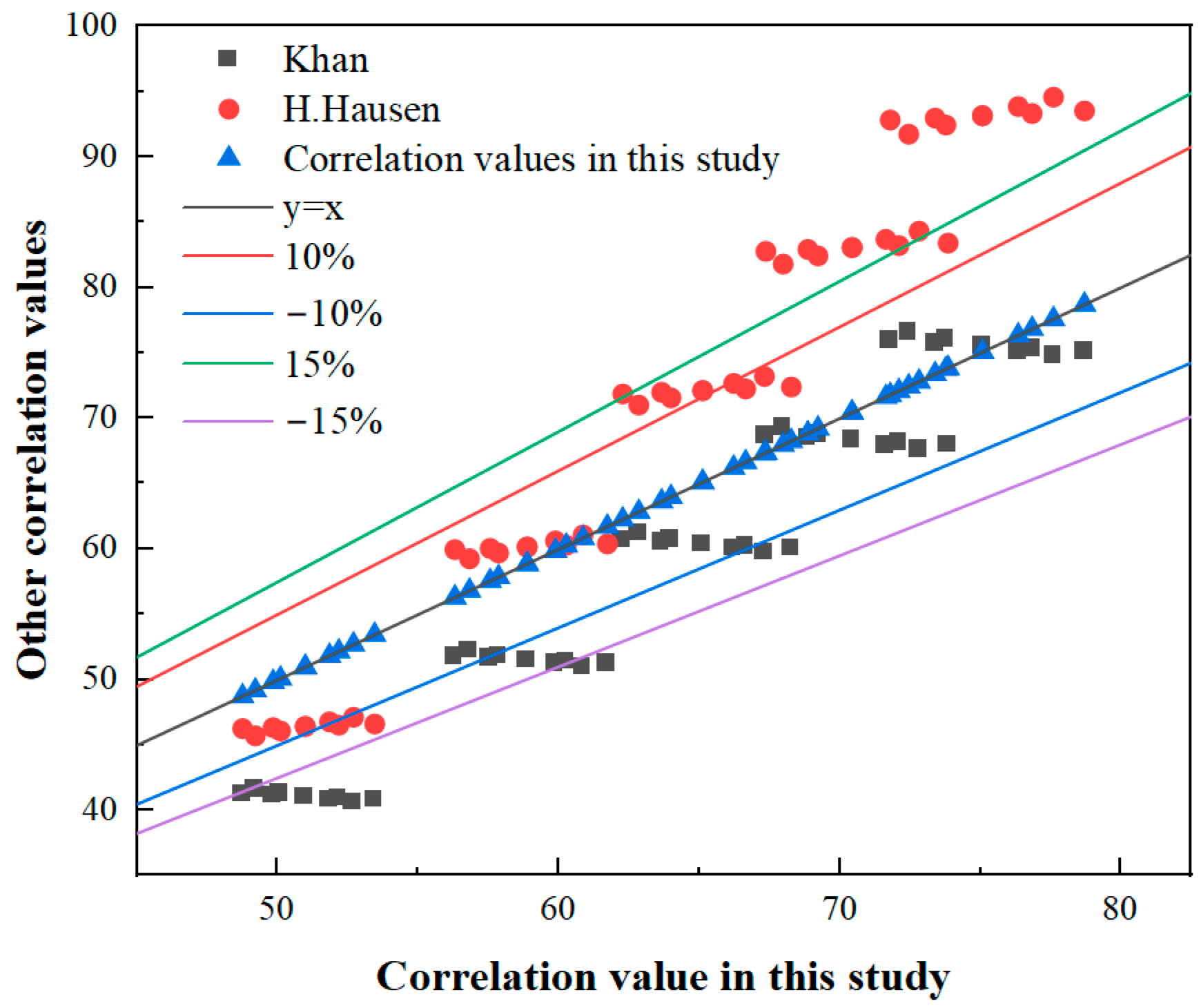
| Value/Unit | Value/Unit | ||
|---|---|---|---|
| Fin parameters | |||
| do | 31 mm | di | 25 mm |
| Lt | 500 mm | SL | 89 mm |
| ST | 104 mm | Front extension | 300 mm |
| Tail extension | 1000 mm | ||
| Boundary conditions | |||
| ug,i | 10.91 m/s | uv,i | 5.3 m/s |
| Tg,i | 1123.15 K | Tv,i | 693.15 K |
| Parameters of the working substance | |||
| Cpg | 0.982 + 1.751 × 10−4 T + 1.821 × 10−7 T2 − 9.285 × 10−11 T3 (J/kg·K) | ||
| λg | −1.729 × 10−4 + 8.421 × 10−5 T + 1.086 × 10−9 T2 (W/m·K) | ||
| μg | 5.030 × 10−6 + 4.509 × 10−8 T − 8.061 × 10−12 T2 (Pa·s) | ||
| Cpv | 3697.09 − 8.46 T + 1.32405 × 10−2 T2 − 6.33368 × 10−6 T3 (J/kg·K) | ||
| λv | −2.67 × 10−3 + 6.63499 × 10−5 T − 1.3815210−8 T2 (W/m·K) | ||
| μv | −9.89223 × 10−7 + 3.6063610−8 T + 1.6469 × 10−14 T2 (Pa·s) | ||
| Case 1 | Case 2 | Case 3 | Case 4 | Case 5 | Case 6 | |
|---|---|---|---|---|---|---|
| Number of grids | 734,582 | 1,438,883 | 2,864,002 | 5,262,399 | 6,576,915 | 7,432,313 |
| Nu | 62.48 | 63.12 | 63.64 | 64.63 | 64.19 | 64.20 |
| ST (mm) | SL (mm) | Average PEC1 | Increment (%) | |
|---|---|---|---|---|
| Primary structural parameters | 104 | 89 | 107.84 | - |
| Transverse tube pitch adjustment | 110 | 89 | 110.34 | 2.32 |
| Longitudinal tube pitch adjustment | 104 | 95 | 117.01 | 8.50 |
Disclaimer/Publisher’s Note: The statements, opinions and data contained in all publications are solely those of the individual author(s) and contributor(s) and not of MDPI and/or the editor(s). MDPI and/or the editor(s) disclaim responsibility for any injury to people or property resulting from any ideas, methods, instructions or products referred to in the content. |
© 2023 by the authors. Licensee MDPI, Basel, Switzerland. This article is an open access article distributed under the terms and conditions of the Creative Commons Attribution (CC BY) license (https://creativecommons.org/licenses/by/4.0/).
Share and Cite
Zhang, D.; Wang, X.; Zhao, L.; Xie, H.; Guo, C.; Qian, F.; Dong, H.; Hu, Y. Numerical Investigation on Heat Transfer and Flow Resistance Characteristics of Superheater in Hydrocracking Heat Recovery Steam Generator. Energies 2023, 16, 6266. https://doi.org/10.3390/en16176266
Zhang D, Wang X, Zhao L, Xie H, Guo C, Qian F, Dong H, Hu Y. Numerical Investigation on Heat Transfer and Flow Resistance Characteristics of Superheater in Hydrocracking Heat Recovery Steam Generator. Energies. 2023; 16(17):6266. https://doi.org/10.3390/en16176266
Chicago/Turabian StyleZhang, Danfeng, Xin Wang, Liang Zhao, Huaqing Xie, Chen Guo, Feizhou Qian, Hui Dong, and Yun Hu. 2023. "Numerical Investigation on Heat Transfer and Flow Resistance Characteristics of Superheater in Hydrocracking Heat Recovery Steam Generator" Energies 16, no. 17: 6266. https://doi.org/10.3390/en16176266





